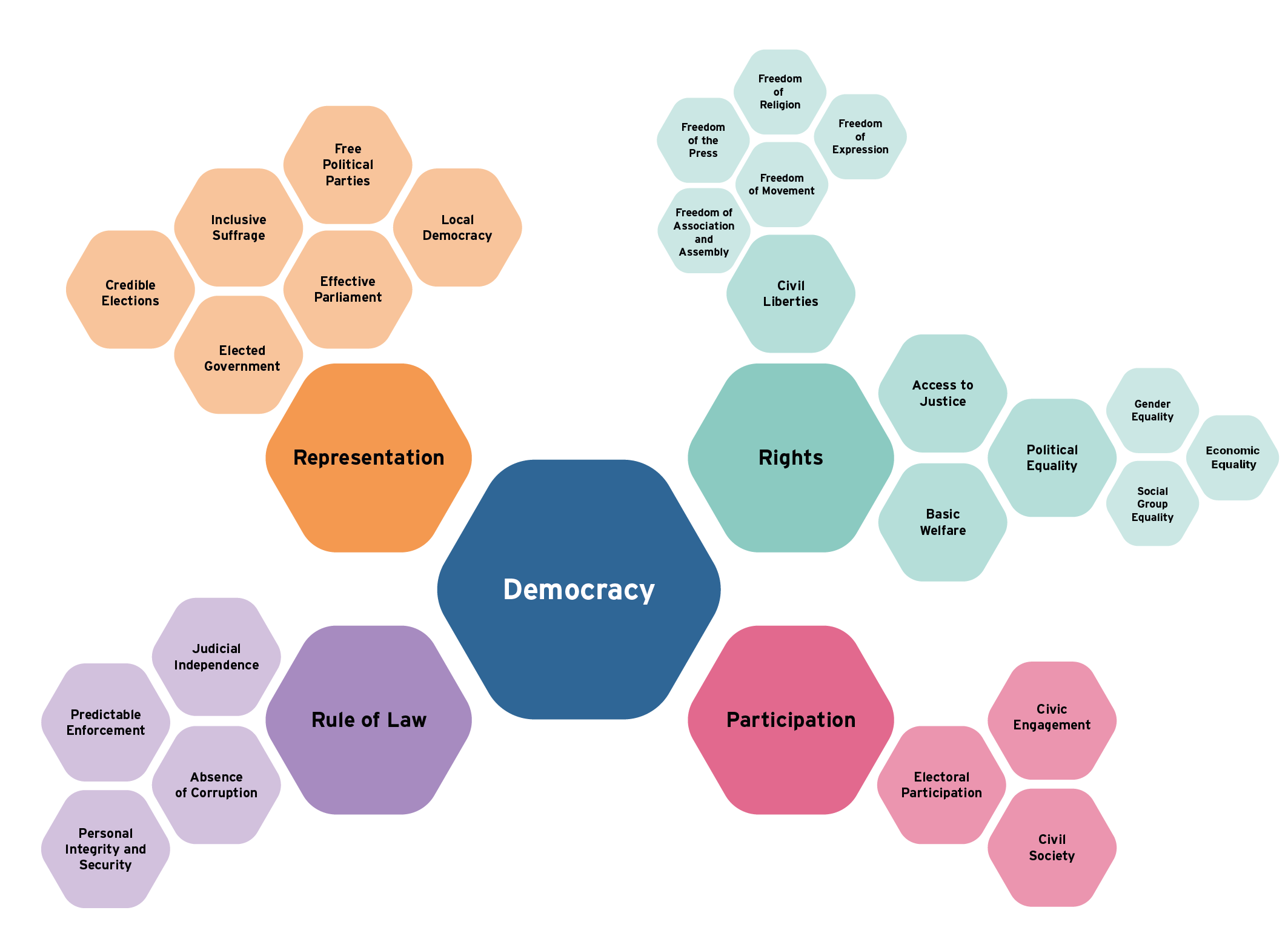
Where to find the data
The figures and data referred to in this Report, unless otherwise stated, are drawn from the Global State of Democracy Indices v8, accessed 10 July 2024.
The Global State of Democracy (GSoD) report, the flagship publication of the International Institute for Democracy and Electoral Assistance (International IDEA), provides annual analysis of democratization in 173 countries across the globe. The GSoD Indices, which are a quantitative data set, provide the majority of the data on which this report is based. The Indices measure national performance across discrete areas of democracy, broadly understood as a system in which there is public control over decision making and decision makers and in which there is equality in the exercise of that control. The data cover the years 1975–2023. The Indices are organized through a hierarchical conceptual framework oriented around four core categories of democratic performance: Representation, Rights, Rule of Law and Participation (see Figure 0.1). Below the four categories are factors (such as Credible Elections or Judicial Independence). Finally, at the lowest level are specific indices, or subfactors (such as Freedom of Expression or Social Group Equality).

GSoD Indices’ conceptual framework
View source
This report is further informed by the Democracy Tracker, a qualitative data project that provides event-centric information on democracy developments in 173 countries¹, with a data series beginning in August 2022 and updated every month after that. The Democracy Tracker reports events that signal a significant change in a country’s democratic performance in a particular month, either positively or negatively, and monitors events that are developing and which could signal that such a change is very likely in the near future (International IDEA 2024d). While the quantitative measures from the GSoD Indices cover only up to December 2023, the Democracy Tracker includes hundreds of reports throughout 2024, many of which are mentioned in this report.
This year’s report additionally draws on the Perceptions of Democracy Survey (PODS). The PODS data set includes popular views of the performance of and access to several political institutions, as well as information on people’s values and satisfaction with government. The survey covers 19 countries². In each country, survey research providers contacted a representative sample³ of the population (approximately 1,000 people) and an additional sample of people whose household income indicated that they were experiencing poverty (approximately 500 people).⁴ This oversampling of the poorest and most marginalized people allows us to have confidence in our assessment of how these diverse groups of people differ from the rest of the population.
The report is also anchored in the subject matter and regional expertise of International IDEA’s staff at our headquarters in Sweden, as well as the work of colleagues in regional and country offices across Africa and West Asia, the Americas, Asia and the Pacific, and Europe. Our staff do more than just keep an ear to the ground; they are involved in the day-to-day efforts to build, protect and expand the work of democratic institutions around the world.
The GSoD Indices aggregate indicators from 24 data sources (see Box 0.1), which include observational data from United Nations agencies, expert-coded data from academic programmes and some data collected directly by International IDEA. The Indices are based on a total of 165 indicators. The result is a collection of 2,088,783 data points on a total of 174 countries over the last 49 years.
References & footnotes
1. The data covered 173 countries in 2023, but the number was lower in years before the mid-1990s. The only country to be dropped from the data set is the German Democratic Republic, which was covered from 1975 to 1990.
2. The survey covers Brazil, Chile, Colombia, Denmark, The Gambia, India, Iraq, Italy, Lebanon, Lithuania, Pakistan, Romania, Senegal, Sierra Leone, the Solomon Islands, South Korea, Taiwan, Tanzania and the United States.
3. The nature of the sample varies slightly from country to country. In 16 of the 19 countries, the main sample (1,000 people) was nationally representative. In Colombia, India and Taiwan, the sample was online representative.
4. One significant exception to this approach is the Solomon Islands, where the small population posed significant challenges for data collection, and the sample size was only 526 people, 309 of whom were in the lowest income category
International IDEA, Democracy Tracker Methodology and User Guide (Stockholm: International IDEA, 2024d), <https://doi.org/10.31752/idea.2024.17>